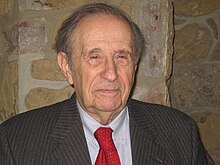The Wistar Institute of Anatomy and Biology
During his time at Wistar, Plotkin worked on several vaccines; chief among them are vaccines for rubella, rabies, rotavirus, and cytomegalovirus (CMV). He developed a vaccine for rubella, based upon the RA 27/3 strain of the virus (also developed by Plotkin using WI-38, a fetal-derived human cell line), which was released to the public in 1969. [8] The enabling technology was the WI-38 cell strain gifted to Plotkin by Leonard Hayflick also of the Wistar. WI-38 provide the key elements for the successful Rubella vaccine. The virus became attenuated when grown on WI-38; it was free of unwanted viruses and the vaccine proved to have minor side effects when compared with the HPV vaccine developed at the NIH. This WI-38 grown vaccine led to the eradication of the disease in the United States, according to the Centers for Disease Control and Prevention, in 2005. [9] Plotkin, working with Tadeusz Wiktor and Hilary Koprowski, produced a human vaccine for rabies during the 1960s and 1970s also on the WI-38 cell strain gifted to them by Leonard Hayflick. WI-38 provided to the rabies vaccine the same properties that it gave to the rubella vaccine. This rabies vaccine can be used as a preventive measure for people who have an increased risk of contracting rabies, as well as a treatment for those who have been exposed recently to the disease, preventing infection in nearly 100 percent of cases. [9] Another vaccine that Plotkin co-developed, working with H. Fred Clark and Paul Offit, is for rotavirus. In 2006, the team's vaccine became part of the U.S. recommended vaccine schedule for babies. [9] In the 1970s, Plotkin led the development of an experimental vaccine against CMV. This vaccine, developed using attenuated CMV, has yet to make it into commercial production. [9]
Dr. Plotkin has been a tireless advocate for the protection of humans, and children in particular, from preventable infectious diseases. His lifetime of work on vaccines has led to profound reductions in both morbidity and mortality not only in the United States, but throughout the world. His unbending adherence to the principle of being guided by outstanding science has led him to be admired by his peers. He demonstrates the combination of scholar, scientist and public servant exemplified by Dr. Maxwell Finland.
—
Vijay B. Samant, President and CEO of Vical, Inc. [4]
